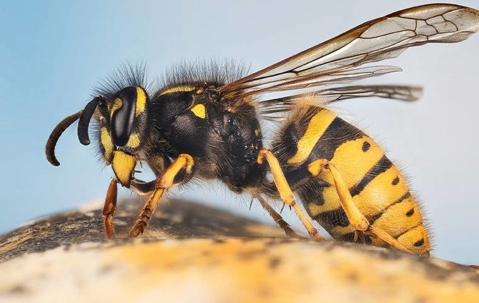Yellow jackets are one of the most common stinging insects in Columbia, and they’re difficult to deter. Unfortunately, yellow jackets pose a serious threat to you and others on your property. Learn more about the dangers of these stinging pests and take action to keep them away from your home.
What Are Yellow Jackets?
Yellow jackets are relatively easy to identify by their yellow and black banded pattern. Equipped with stingers and wings, yellow jackets look like bees but have narrow waists like wasps. It’s worth mentioning that some yellow jackets don’t have well-known color patterns. Instead, they have red or white bands.
Usually, it’s the behavior of yellow jackets that make them stand out from Columbia hornets and wasps. They can be highly aggressive depending on the species. In all, there are 16 species of yellow jackets in the United States. None of the species enjoy being bothered by humans, and all yellow jackets will sting if they feel threatened.
Yellow jackets are social insects and have year-round colonies. The queen survives the winter and starts a fresh colony in the spring. When she looks for a nesting site, she searches for either an underground or aerial site. If she picks an aerial location, the nest may be in bushes, trees, or eaves.
As you may expect, yellow jackets like the sugar found in nectars, fruit, and soda. But you might not realize that these insects also look for protein. When in the larval stage, yellow jackets eat other insects. The worker insects find insects and other sources of protein to carry back to the larvae. If you have caterpillars in your garden, you can count on yellow jackets to make them disappear.
Why Yellow Jackets Are So Dangerous
There are a few reasons yellow jackets are highly dangerous to humans. For one, they can trigger an allergic reaction in a vulnerable person. If you or a loved one has an allergy to yellow jacket venom, you could go into anaphylactic shock. Immediate medical attention is necessary, or the consequences could be fatal.
Another danger comes from the fact that you can develop a reaction at any time. Although you may have been stung before and never had a bad reaction, you could still be in danger. The next time a yellow jacket stings you, there’s a chance you will have an allergic reaction.
Making the situation worse is the fact that yellow jackets sting multiple times. After it stings you, the insect could continue to do so until it doesn’t perceive you as a threat. Other insects in the colony may also join in. Whether you accidentally bump into a nest or you disturb it while trying to eliminate the nest, you are likely to experience multiple stings.
Preventing Yellow Jacket Stings
If you have yellow jackets on your property, you could be in danger. The only way to stay safe is to take measures to keep yellow jackets away and to call a professional as soon as you spot a nest on your property. On your own, you can take the following measures to keep these pests away:
- Close garbage can lids
- Trim hedges and shrubs
- Seal up possible nesting areas
- Keep sweet food indoors
For the best results, work with us at Go-Forth Home Services. We’ve been protecting Columbia residents from yellow jackets for years. Our professionals have extensive training and the know-how to safely remove and deter yellow jackets. With a focus on customer satisfaction, we take the time to know your property and your pest control needs. If you’re ready to get started or you have any questions, give us a call now.

